AMERICAN CURLY HORSE
The Curly Horse of America
Welcome to the owners and breeders
of
Curly
horses webpage. This page is devoted to
giving current information regarding
the history, characteristics and types of
Curly horses. There are three
registries representing the Curly horse. The
American Bashkir Curly Registry
and the
American Curly Horse Association and The International Curly
Horse Organization. We
hope you enjoy the site &
the amazing Curly Horse !

~~~ THE HISTORY OF CURLY HORSES ~~~
~~ Curly horses in America were known to
the Native Americans. The Crow
and Sioux both had Curly horses. The
documentation of this is found in
their calendars called "Winter Counts" which
are picture books of sketches
showing events during certain years. In the
winter of 1801-02 it shows
a drawing of a Curly horse and is remembered
as the winter the Sioux stole
Curly horses from the Crow. The Curly has
been said to be sacred horses
to the Indians, called Buffalo Ponies &
owned by Chiefs & Medicine
Men. A Native American depicted Curly horses
at the battle of Little Bighorn
of 1876 in drawings he made. Curly horses
were found at the Standing Rock
Reservation in South Dakota. They have also
been found at the Fort Berthold
Reservation in North Dakota & at Rock
Springs, Wyoming.
~~ The Damele`s are the most well know
for their breeding of Curly
horses in Nevada. Giovanni (John) Damele, an
Italian immigrant, settled
near Eureka, Nevada with his family and
started ranching. They spotted
Curly horses in the mustang herds of Nevada
as early as the late 1800`s.
In the winter of 1932 almost all the
livestock & horses died because
of severe weather. When horses were rounded
up in the spring, a few straight
haired horses and some Curlies were alive.
These Curlies were used to
breed with other horses and many Curly foals
were produced. In 1952 another
severe winter storm developed and all the
horses died except a Curly colt
(Copper D) and four Curly mares. The first
Curly stallion used by the Damele`s
was Copper D. The Curlies were bred to the
Arabian stallion Nevada Red
& a Morgan stallion Ruby Red King. Other
breeds used for breeding to
Curlies were, Appaloosa, Saddlebred, Quarter
horse & Draft. The Damele`s
continued to breed Curly horses for many
years. Most of the Curly horses
of today trace back to the Damele Curlies.
The Damele`s and other breeders
bred Curlies to a variety of other breeds
because their numbers were very
limited. In the 1960`s they were bred to the
Missouri Foxtrotter and today
there are some foxtrotting Curlies that carry some of the best old time MFT gaiting bloodlines. There are
approximately 2000 living
registered Curly horses. Today there is also
much less outcrossing and
many breeders prefer to breed Curly to Curly.
There is also a group of
breeders working to preserve the original
type of Curly.

~~~~~~ CURLY CHARACTERISTICS ~~~~~~
~~ The winter coat of the Curly horse has
curls in the form of tight
ringlets to a marcel type wave. The hair is
generally soft and is hypoallergenic.
Most people allergic to horses are not
allergic to the Curly. The curly
hair has been tested and has been found to
resemble mohair. The hair can
be spun into yarn. The mane & tail is
also curly, wavy or in dredlocks.
In the summer the curly coat sheds out to a
smoother or slightly wavy hair
coat. Some Curlies also shed their mane and
tail hair, while others shed
a partial amount and some retain the mane
& tail.
~~ The Curly horse is quite hardy and
has the ability to withstand
colder temperatures than many other breeds.
They posess strong round hooves.
The bone thickness is also greater in the
Curly than other breeds of horses.
Their cannon bone is round rather than flat.
They do not seem to be plagued
by diseases that affect other equine
breeds.
~~ The eyes of the Curly are spaced
wide apart so they have good
rear vision. The eyes have a sleepy look to
them and are hooded. The nostrils
are cresent shaped, not flaring. They have a
small teacup mouth.
~~ One of the best traits of the Curly
is their personality. They
love people. They are intelligent, quick to
learn, willing partners. They
have a quiet temperment and do not spook
& run, but rather face their
fear to get a good look at it. They are
curious little clowns at times.
~~ The athletic ability of the Curly
has taken him to the dressage
ring, endurance rides, cow pony work,
driving, Western peasure, ideal family
horse & hunter of Buffalo by the Indians.
Curlies seem to excel at
many tasks. They have plenty of engery and
endurance. They have great
movement and style.

~~~~~~ TYPES OF CURLY HORSES ~~~~~~
There is a "dominant" and "recessive"
gene responsible for giving
horses curly hair. The dominant gene is the
most prevelant in the registered
Curly horses. A double dominant (homozygous) gened Curly
will produce curls when bred
to another Curly or a straight coated horse.
There are also recessive curly
haired horses that are the product of a
straight haired sire & dam.
The Percheron, Missouri Foxtrotter & Paso
Fino are a few breeds that
have produced "recessive" curly
offspring.
~~~~~~ Native American Curlies ~~~~~~
~~ A small number of Curlies were obtained
from Native American Eli
Bad Warrior. These Curlies were kept by the
Native Americans and passed
down to their family members. The Native
Curlies have a regal presence
about them & a keen sense of what is
going on around them. They are
built heavy and solid with good bone. They
tend to be a bit shy around
strangers.
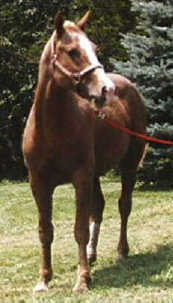 ~~ A Native American
stallion, Red
Hawk
~~ A Native American
stallion, Red
Hawk
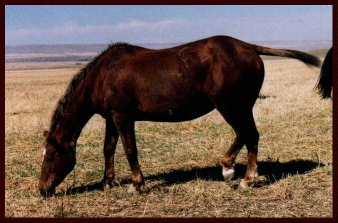 ~~ A Native American mare, Miss Berndt
Warrior
~~ A Native American mare, Miss Berndt
Warrior
~~~~~~~ BLM Curlies ~~~~~~~
Curlies are also occasionally
found in the mustang herds in
Rock Springs, WY.
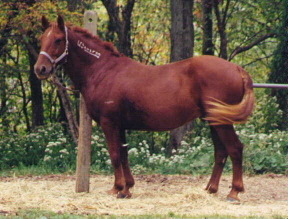 ~~ BLM adopted Curly
from Rock
Springs, WY
~~ BLM adopted Curly
from Rock
Springs, WY
~~~~~~~ Damele Curlies ~~~~~~~
~~ The Curlies found by the Damele family
were bred for many years on
their ranch. This line of Curlies has been a
great influence on many Curlies
of today as most can trace their pedigrees
back to the Damele breeding
stock.
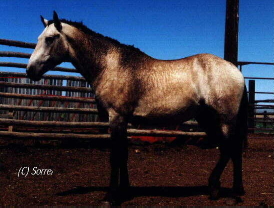 ~~ Damele stallion
Mead`s Grulla
Horse
~~ Damele stallion
Mead`s Grulla
Horse
(This photo taken by
Gaby Kaercher of Germany. It
is copyrighted and may not be
reproduced.)
 ~~ Damele stallion
Colonel`s Fiesty
Fella~
~~ Damele stallion
Colonel`s Fiesty
Fella~
~~~~~~ Gaited Curlies ~~~~~~~
~~ Only about 10% or less, of Curlies today are
gaited. A few do a natural running
walk. Some Curlies were bred to the Missouri
Foxtrotter in the 1960`s,
and hence some Curlies now do the foxtrot
gait. Some Curlies have also
been bred to Tennessee Walkers and do a
running walk. Both the foxtrot
and running walk are smooth riding gaits with
no bounce.
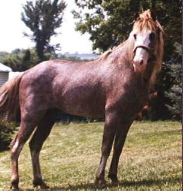 ~~ Foxtrotting Curly
stallion Sir
Patrick
~~ Foxtrotting Curly
stallion Sir
Patrick
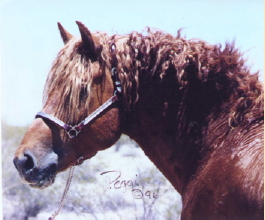 ~~ Copper Sun, Curly
stallion that
does a natural running walk.
~~ Copper Sun, Curly
stallion that
does a natural running walk.
~~~~~~~ Caring For Curly Horses ~~~~~~
~~ Curlies are generaly easy keepers that
enjoy the great outdoors.
Like all horses though, they need shelter
available in inclimate weather.
A barn or three sided shelter works great as
a wind break. They should
be fed quality grass or mixed hay with fresh
water always available. Grain
can also be fed but they do not need large
amounts. Like all horses they
need regular worming, vaccinations and hoof
care. Curlies deserve the best
of care and thrive under good conditions.
Good basic horse care applies
to all breeds, even Curlies.
~~~~~~~~~~~~~~~ Grooming ~~~~~~~~~~~~~~
~~ Curlies love to be groomed. Even in
their winter curls, it is easy
to keep their coats looking good by brushing
& of course the Curly
will thoroughly enjoy it. In the spring when
they start to shed, a brush,
shedding blade or comb works great to remove
the shedding curls. You can
keep the shedded hair and spin it into yarn
or find a spinner in your area
that maybe interested in exotic fiber.
~~~~~ CURLY HORSE LINKS ~~~~~
Curly
Horse Breeders
Curly
Stallion Showcase
Curly
Horse Sales
Curly
Horse Products
Gaited
Curly Horses
Curly Horse Registries

~~ A Native American
stallion, Red
Hawk
~~ A Native American mare, Miss Berndt
Warrior
~~ BLM adopted Curly
from Rock
Springs, WY
~~ Damele stallion
Mead`s Grulla
Horse
~~ Damele stallion
Colonel`s Fiesty
Fella~
~~ Foxtrotting Curly
stallion Sir
Patrick
~~ Copper Sun, Curly
stallion that
does a natural running walk.